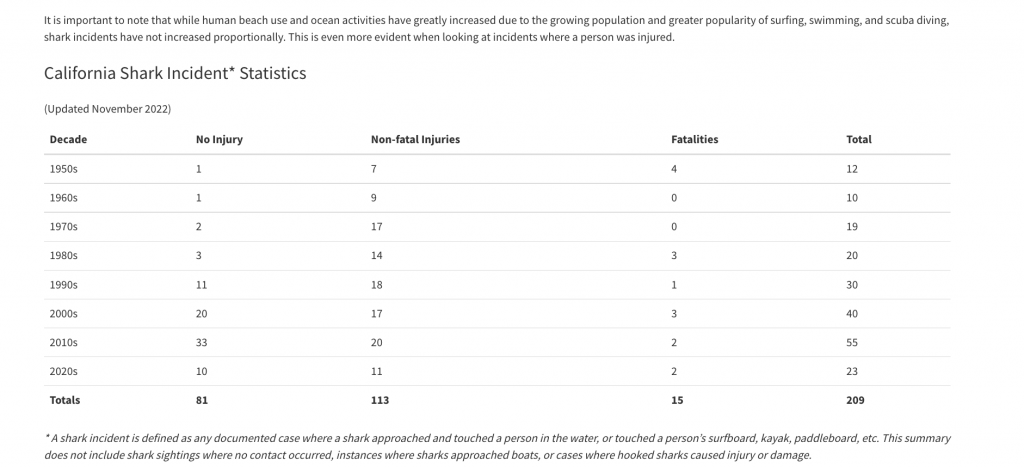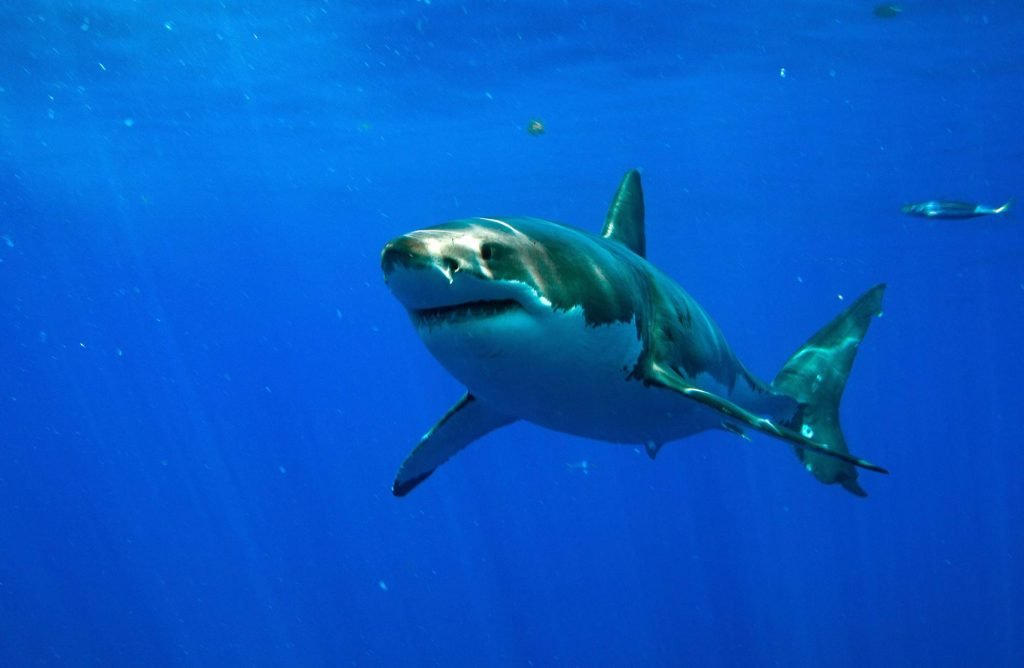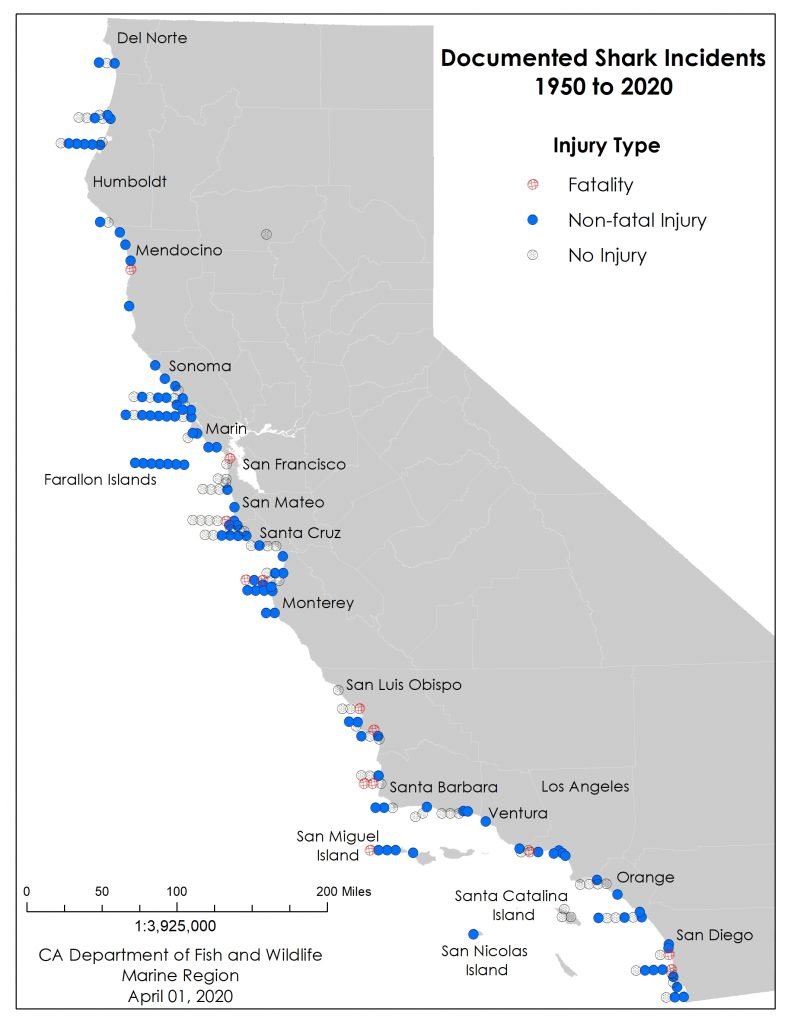White sharks, also called great white sharks (Carcharodon carcharias), are one of the ocean’s primary predators, and fascinating creatures to many. However, many people are in fear of white sharks and have a deep misunderstanding around these fascinating and important apex predators.
Although white sharks are often in the news and they are characterized as the most common villains in films like Jaws and programs like Shark Week, white sharks remain one of the least understood of the sea’s creatures. This is a despite the enormously popular and scientific interest in them. It is important to note that even though human use of the water over the years has greatly increased due to the growing human population and the popularity of surfing, swimming, and scuba diving, white shark incidents have not increased in a parallel manner.
White Shark Stewardship
With the Greater Farallones National Marine Sanctuary, Shark Stewards helped develop and participates in the white shark stewardship program creating standardized white shark science and education programs. This program works with agencies, researchers and the public collecting data and providing white shark education. Each fall, we lead expeditions into the Sanctuary to educate the public and sometimes even see these amazing animals.

Questions about white sharks
Text by Carrie Wilson, Associate Marine Biologist, Mary Patyten, and David McGuire.
“How common are shark attacks on humans?”
While sharks don’t typically prey upon humans, white sharks do pose an extreme threat if you meet them on their “turf”, or maybe in this case “surf.” Over the past two decades, the California Department of Fish and Wildlife has statistically estimated 1.8 human- shark encounters with humans per year off the west coast of North America per year. Deaths by a white shark attack averages approximately one every five years over the past two decades. Of all species in California, bites from species other than white shark (such as blue and hammerhead sharks) are very rare and usually involve fishing. Bites incurred while fishing, spearfishing, freediving for prey or feeding sharks are considered provoked attacks.
Since 1950, there have been 209 shark incidents* in California involving all species of sharks, at least 185 of which involved white sharks. Of those, 15 were fatal and all of the fatalities involved white sharks as of December 2022.
* A shark incident is defined as any documented case where a shark approached and touched a person in the water, or touched a person’s surfboard, kayak, paddleboard, etc. This summary does not include shark sightings where no contact occurred, instances where sharks approached boats, or cases where hooked sharks caused injury or damage.
- Download a Summary of California Shark Incidents (PDF)(opens in new tab)
- Download a List of California Shark Incidents Since 1950 (PDF)

Over one third of white shark human encounters occur in what is known as the “Red Triangle” located in North Central California. 21 of the 104 recorded white shark attacks on humans in California have been south of Point Conception within the past 63 year period.
Download a Summary of California Shark Incidents (PDF)
“What do white sharks typically eat?
Juveniles typically feed on fishes, small sharks, and rays. Both adults and juveniles are ambush predators. Adults have a wider menu than juveniles which includes fishes, seals, sea lions, dolphins, whale blubber (scavenged), seabirds, marine turtles, rays, and other sharks.
“How large do white sharks get?
Adult white sharks grow to about 21 ft. long and dominate their domain as one of the top-level predators of the ocean. A female white shark was captured off Pt. Vincente in September 1986 that measured 17.6 ft and weighed 4,140 lbs.
“Where do white sharks occur?”
White sharks are widely distributed around the world, mostly in cold, temperate seas, only occasionally occurring in tropical seas. They prefer waters with sea surface temperatures of 50-72 F. White sharks have been known to range as deep as 6,150 ft.
“What is the white sharks’ role in the marine ecosystem?
White sharks play a crucial role in the marine ecosystem by helping to suppress pinniped (seals and sea lions) populations. The only real threats white sharks face are from humans, as well as the occasional killer whale.
According to marine fisheries expert, Burr Heneman, who drafted California’s white shark protection legislation, “White sharks, orcas, and disease are about the only factors limiting seal and sea lion populations in California, and research increasingly confirms that the white shark population is pretty small and highly vulnerable to fishing pressure.”
“How large is the white shark population?”
Currently, there are no population estimates available for white sharks. However, there is agreement among shark biologists that their numbers are very low. Low numbers are typical for top-level, apex predators that are long-lived, slow growing, late-maturing, and have a low reproductive potential.

“What do scientists know about the white shark population?”
Since there is no fishing data available, scientists assess the population numbers of white sharks using other methods. One method is to collect tissue samples and extract DNA samples for analysis. These studies are used to determine whether there are multiple populations of animals or just one white shark population that’s spread out over large areas. This research on white sharks is still in its infancy.
“Are there any examples of how scientists are trying to get a better handle on how large white shark populations are?”
Scientists at the Farallon Islands visually document each individual shark based on unique external characteristics (e.g. scars, marks, fin shapes, unique coloration patterns, etc.) They then note any re-sightings of each recorded animal. It may soon be possible to use mark-and-recapture statistical sets to estimate the actual numbers of animals occupying that area. Evidence so far supports the notion that the number of adult white sharks around the Farallon Islands and, very possibly all of California, is under 100.
Tagging white sharks with special satellite tags is another method which enables scientists to determine the range and movements of the big beasts, whether there’s just one population or multiple populations moving up and down the coast, and just how free-roaming they are. Recently, a shark tagged off of the California coast was tracked moving to Hawaii and back for two years in a row using these tags.
“Is fishing for white sharks illegal?”
White sharks are indeed illegal to take and have been protected in all California waters since January 1, 1994. Title 14, California Code of Regulations, Fish and Game Code Section 28.06 on page 25 of the California Sportfishing Regulations booklet clearly states that white sharks many not be taken under a sport fishing license. Commercial fishing operations may not target white sharks, either.
“Are white sharks protected all over the world?”
No. In areas of the world not yet protecting white sharks, they have become a popular trophy fish with each bringing thousands of dollars for just their valuable fins and jaws alone.
Fear has motivated the targeting and persecution of white sharks, and all sharks, for decades. White sharks have been listed as “vulnerable” on the International Union for the Conservation of Nature and Natural Resources’ “Red List” of threatened species, and are now regionally protected in many areas of the world including South Africa, Namibia, the Maldives, Malta, Australia, the U.S. Atlantic Seaboard and Gulf Coast (including Florida), and the coast of California (since 1994), where it is illegal to pursue, capture, or possess them in whole or in part. Unfortunately, they have not been granted full international protection yet, which allows a sizable black market network to perpetuate the sale of white shark jaws and teeth.
“What groups were in favor of white shark protection in California?”
Shark Stewards, and California Academy of Science Dr. John McCosker were instrumental in protecting white sharks in California in 1993. According to marine fisheries expert, Burr Heneman, Northern California surfers were among the most active supporters of white shark protection when the legislation was adopted in 1993. The following letter was even written to the bill’s author, then Assemblyman Dan Hauser, by Eric Larsen, a surfer who needed 200 stitches after being hit by a white shark while surfing at Davenport two years earlier:
“I am writing to express my support for AB 522 to protect white sharks in California. As you may know, I was mauled by a shark thought to be a Great White on July 1, 1991 while surfing near Davenport, CA. My experience with the shark convinced me that sharks are an important part of the natural order of things. Any creature which is as well-adapted to its environment as the shark deserves a lot of respect.”
While Northern California diver organizations supported the legislation, those in Southern California, where there have been few incidents, seemed nervous about protecting white sharks and never actively supported the bill.
“How do you tell white sharks from other species of sharks?”
According to Dr. Robert Lea, senior biologist and shark expert for CDFW, “If you see a shark greater than 15 ft. in California waters, chances are it’s a white shark.” White sharks have heavy spindle-shaped bodies with conical snouts and a narrow tail stalk supported by stout lateral keels. Their coloration reflects a sharp demarcation between dark upper surfaces and white lower surfaces. The pectoral fins have a white trailing edge, black tips on the undersides, and a black spot occurs at the pectoral axil (“armpit”) in some individuals. Their jaws are loaded with large, triangular, serrated teeth.
View a sketch of a white shark compared to other sharks in the same family 
(Lamnidae, the mackerel sharks), from California Fish and Game Bulletin 157, by Miller and Lea
“How often do white sharks reproduce?”
White sharks are long-lived, and not very abundant. Male white sharks become sexually mature at around 9-10 yrs. of age. Females become mature at around 14-16 yrs. of age, and can have between two and 14 “pups” per litter. Birthing is thought to occur in the spring and summer months. Each pup is around 4-5 feet long at birth, and comes equipped with a full set of teeth. White sharks, as with most long-lived ocean creatures, suffer from high mortality rates during their first year of life.
Scientists believe white shark gestation periods last about 12 months, which means that female white sharks may breed only once every two years. This slow rate of reproduction indicates that it would take a long time for white shark populations to recover if they became severely depleted.

“How can people avoid white shark attacks?”
There is only one foolproof method for avoiding a white shark attack: stay out of the ocean. If this is not an option, try to avoid places known for white sharks, such as the Farallon Islands, Año Nuevo, and Bird Rock near Point Reyes. Another suggestion is to avoid swimming in areas where marine mammals are congregating. Don’t swim in or near areas frequented by sea lions, harbor seals, and elephant seals, etc. or near their rookeries.
Wearing a wetsuit and fins, or lying on a surfboard, creates the silhouette of a seal from below. Shark attacks are often believed to be cases of mistaken identity, with surfing or swimming humans mistaken for seals or sea lions. Times of reduced sunlight, such as foggy mornings or dusk, are ideal times to be mistaken for a seal.
“How do white sharks find their prey?”
White sharks initially use vision to find their prey, but then switch to a special organ located in their snouts that senses electrical pulses from the body, such as those generated by muscle movement or a beating heart.
To keep these articles free please consider a tax-deductible donation. Last updated December 22, 2022.
Shark Encounter Information
Summary of Shark Encounters in California 
Complete Listing of Shark Encounters in California
Summary of Injuries Resulting from California Shark Encounters 
Listing of Shark Encounters in Oregon and Washington 
Listing of Fatal Shark Encounter Incidents 
Map: White Shark Attack Occurrences in California from 1926-2004 